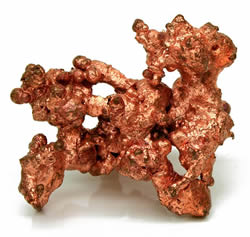Water Testing for Copper in Connecticut

Why should I have water testing done for copper in my Connecticut home?
Copper is a reddish metal that occurs naturally in rock, soil, water, sediment and air. It is commonly found in pennies, electrical wiring and water pipes. It is an essential element for living organisms, including humans. In small amounts, copper is a necessary part of our diet to ensure good health.
Copper occurs in CT drinking water primarily due to its use in plumbing materials and the subsequent corrosion of copper pipes. As with lead, all water is corrosive toward copper to some degree.
Corrosivity toward copper depends primarily on the pH (acidity) of the water. Acidic water (very low pH) is associated with the highest levels of copper corrosion in Connecticut. Many of the other factors that affect the corrosivity of water toward lead can also be expected to affect the corrosion of copper.
What are the health effects of Copper?
While copper is an essential nutrient, too much copper can cause adverse health effects, including vomiting, diarrhea, stomach cramps and nausea. Long-term exposure (more than 2 weeks) to copper also is associated with liver damage and kidney disease in infants under 1 year. People with liver damage or Wilson’s disease are also more susceptible to copper toxicity.
The U.S. Environmental Protection Agency (EPA) set a limit of 1.3 parts per million for levels of copper in public water supplies, at which steps must be taken to control corrosivity in the water. This standard can be used as a guideline for tests on the water from your private well in Connecticut.
How do I test for Copper in my CT Water?
Before copper levels are high enough to harm your health, you may notice a metallic taste in your drinking water. You may also notice blue or blue-green stains around sinks and plumbing fixtures. The only way to be certain of the copper level in your CT drinking water supply is to have the water tested.
The EPA’s scientific data indicate that the newer the home, the greater the risk of copper contamination from new pipes. Copper levels decrease as a building ages. Over time, mineral deposits form a coating on the inside of the pipes, as long as the water is not corrosive. This coating insulates the water from the copper. However, during the five years it takes for this coating to form, water is in direct contact with the copper.
You should be concerned:
- if your home has copper pipe
- if you see signs of corrosion, such as frequent leaks, rust-colored water, stained dishes or laundry
- if your non-plastic plumbing is less than five years old
If your water testing results show elevated levels of copper in your Connecticut drinking water, it is likely that your lead levels may also be elevated, since lead and copper enter water under similar conditions. For this reason, you may wish to test your water for lead when you test for copper.
What are the treatments for Copper in Connecticut drinking water?
Take the following steps to reduce your household’s exposure to copper:
- Run water for at least 15 to 30 seconds before drinking it, especially if you have not used your water for a few hours. Refrain from consuming water that has been in contact with your home’s plumbing for more than six hours, such as overnight or during your work day.Before using water for drinking or cooking, “flush” the cold water faucet by allowing the water to run until you can feel that the water has become as cold as it will get. You must do this for each drinking water faucet. Taking a shower will not flush your kitchen tap.Flushing is important because the longer water is exposed to copper pipes, the greater the possible contamination. The water that comes out after flushing will not have been in extended contact with copper pipes.
- Use only cold water for drinking and cooking. Never cook with or consume water from the hot-water tap. Hot water dissolves more copper more quickly than cold water. If you need hot water, draw water from the cold tap and heat it on the stove or in the microwave. Use only thoroughly flushed water from the cold tap for any consumption in CT.
- Take steps to reduce the corrosivity of your household water. Connecticut well owners can treat their water to make it less corrosive. Corrosion control devices include calcite filters and other devices. Calcite filters should be installed in the line between the well and any copper pipe.
- Consider point-of-use filters on household faucets in the kitchen and bath. There are a number of water filtering devices available. These employ media, such as carbon, ion exchange resins or activated alumina to filter copper from water. Remember to replace the filter periodically, as specified by the manufacturer.The effectiveness of these devices to reduce copper exposure at the tap can vary greatly. Before purchasing a filter, verify the copper treatment claims made.
To determine the copper level in your drinking water call today to set up an appointment. 888-558-1574









